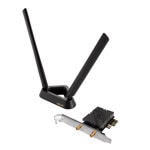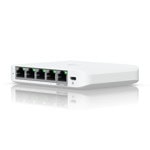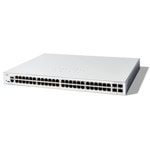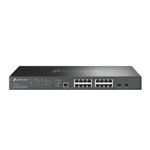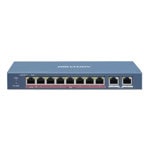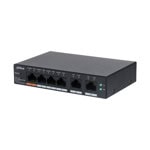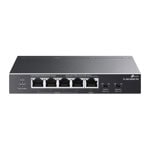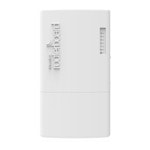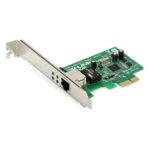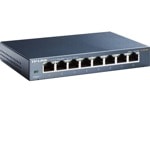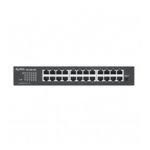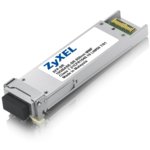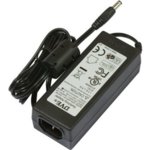Cisco Catalyst 2960-L
WS-C2960L-48TS-LL
Cisco Catalyst® 2960-L Series Switches are fixed-configuration, Gigabit Ethernet switches that provide entry-level enterprise-class Layer 2 access for branch offices, conventional workspaces, and out-of-wiring closet applications. Designed for operational simplicity to lower total cost of ownership, they enable secure, and energy-efficient business operations with a range of Cisco IOS® Software features.
Technical Specifications
48 x 10/100/1000 Ethernet Ports
4 x SFP Ports
Console Ports:
1 x RJ45 Ethernet
1 x USB mini-B
1 x USB-A port for storage and Bluetooth console
Memory and Processor:
ARMv7 800 MHz CPU
512 MB DRAM
256 MB Flash Memory
Performance
Forwarding bandwidth: 52 Gbps
Switching bandwidth: 104 Gbps
Forwarding rate (64‑byte L3 packets): 77.38 Mpps
Unicast MAC addresses: 8K
Maximum active VLANs: 64
VLAN IDs available: 4094
Maximum STP instances: 64
Maximum SPAN sessions: 1
MTU-L3 packet: 9198 bytes
Jumbo Ethernet frame: 10,240 bytes
MTBF in hours (Data): 1,370,769
Features
Network Security: The Cisco Catalyst 2960-L Series Switches provide a range of security features to limit access to the network and mitigate threats, including:
● Comprehensive 802.1x features to control access to the network, including flexible authentication, 802.1x monitor mode, and RADIUS change of authorization.
● Multidomain Authentication allows an IP phone and a PC to authenticate on the same switch port while placing them on appropriate voice and data VLANs.
● Access Control Lists (ACLs) for IPv6 and IPv4 for security and QoS ACEs:
◦ Port-based ACLs for Layer 2 interfaces allow security policies to be applied on individual switch ports.
● Secure Shell (SSH) Protocol, Kerberos, and Simple Network Management Protocol Version 3 (SNMPv3) provide network security by encrypting administrator traffic during Telnet and SNMP sessions. SSH Protocol, Kerberos, and the cryptographic version of SNMPv3 require a special cryptographic software image because of U.S. export restrictions.
● Switched Port Analyzer (SPAN), with bidirectional data support, allows Cisco Intrusion Detection System (IDS) to take action when an intruder is detected.
● TACACS+ and RADIUS authentication facilitates centralized control of the switch and restricts unauthorized users from altering the configuration.
● MAC address notification allows administrators to be notified about users added to or removed from the network.
● Multilevel security on console access prevents unauthorized users from altering the switch configuration.
● Bridge Protocol Data Unit (BPDU) guard shuts down spanning-tree port fast–enabled interfaces when BPDUs are received to avoid accidental topology loops.
● Spanning-tree Root Guard (STRG) prevents edge devices not in the network administrator’s control from becoming Spanning Tree Protocol root nodes.
● IGMP filtering provides multicast authentication by filtering out nonsubscribers and limits the number of concurrent multicast streams available per port.
● Dynamic VLAN assignment is supported through implementation of VLAN membership policy server client capability to provide flexibility in assigning ports to VLANs. Dynamic VLAN facilitates the fast assignment of IP addresses.
Redundancy and Resiliency: Cisco Catalyst 2960-L Series Switches offer a number of redundancy and resiliency features to prevent outages and help ensure that the network remains available:
● IEEE 802.1s/w Rapid Spanning Tree Protocol (RSTP) and Multiple Spanning Tree Protocol (MSTP) provide rapid spanning-tree convergence independent of spanning-tree timers and also offer the benefits of Layer 2 load balancing and distributed processing.
● Per-VLAN Rapid Spanning Tree (PVRST+) allows rapid spanning-tree reconvergence on a per-VLAN spanning-tree basis, without requiring the implementation of spanning-tree instances.
● Switch-port autorecovery (error disable) automatically attempts to reactivate a link that is disabled because of a network error.
Enhanced Quality of Service: The Cisco Catalyst 2960-L Series Switches offers intelligent traffic management that keeps everything flowing smoothly. Flexible mechanisms for marking, classification, and scheduling deliver superior performance for data, voice, and video traffic, all at wire speed. Primary QoS features include:
● Up to four egress queues and two thresholds per port supporting bandwidth control, shaping, and priority queuing so that the high priority packets are serviced ahead of other traffic.
● Weighted Round Robin (WRR) scheduling and Weighted Tail Drop (WTD) congestion avoidance.
● 802.1p class of service (CoS) classification, with marking and reclassification on a per-packet basis by source and destination IP address, MAC address, or Layer 4 TCP/UDP port number.
Cisco Catalyst SmartOperations: Cisco Catalyst SmartOperations is a comprehensive set of capabilities that simplify LAN planning, deployment, monitoring, and troubleshooting. Deploying SmartOperations tools reduces the time and effort required to operate the network and lowers TCO.
● Cisco AutoConfig services determine the level of network access provided to an endpoint based on the type of the endpoint device. This feature also permits hard binding between the end device and the interface.
● Cisco Smart Install services enable minimal-touch deployment by providing automated Cisco IOS Software image installation and configuration when new switches are connected to the network. This enables network administrators to remotely manage Cisco IOS Software image installs and upgrades.
● Cisco Auto SmartPorts services enable automatic configuration of switch ports as devices connect to the switch with settings optimized for the device type resulting in zero-touch port-policy provisioning.
● Cisco Smart Troubleshooting is an extensive array of diagnostic commands and system health checks in the switch, including Smart Call Home. The Cisco Generic Online Diagnostics (GOLD) and Cisco online diagnostics on switches in live networks help predict and detect failures more quickly.
● PnP (Plug and Play) with Cisco APIC – EM (Application Policy Infrastructure Controller Enterprise Module) support for simple, secure, unified, and integrated new branch or campus device deployments or for provisioning updates to an existing network.
Operational Simplicity Features:
● Cisco AutoSecure provides a single-line command-line interface (CLI) to enable baseline security features (Port Security, DHCP snooping, Dynamic ARP Inspection (DAI)). This feature simplifies security configurations with a single touch.
● Dynamic Host Configuration Protocol (DHCP) autoconfiguration of multiple switches through a boot server eases switch deployment.
● Autonegotiation on all ports automatically selects half- or full-duplex transmission mode to optimize bandwidth.
● Dynamic Trunking Protocol (DTP) facilitates dynamic trunk configuration across all switch ports.
● Port Aggregation Protocol (PAgP) automates the creation of Cisco Fast EtherChannel groups or Gigabit EtherChannel groups to link to another switch, router, or server.
● Link Aggregation Control Protocol (LACP) allows the creation of Ethernet channeling with devices that conform to IEEE 802.3ad. This feature is similar to Cisco EtherChannel technology and Port Aggregation Protocol (PAgP).
● Automatic media-dependent interface crossover (MDIX) automatically adjusts transmit and receive pairs if an incorrect cable type (crossover or straight-through) is installed.
● Unidirectional Link Detection Protocol (UDLD) and aggressive UDLD allow unidirectional links caused by incorrect fiber-optic wiring or port faults to be detected and disabled on fiber-optic interfaces.
● Local Proxy Address Resolution Protocol (ARP) works in conjunction with private VLAN edge to minimize broadcasts and maximize available bandwidth.
● VLAN1 minimization allows VLAN1 to be disabled on any individual VLAN trunk.
● Internet Group Management Protocol (IGMP) snooping for IPv4 and IPv6 MLD v1 and v2 snooping provide fast client joins and leaves of multicast streams and limit bandwidth-intensive video traffic to only the requestors.
● Per-port broadcast, multicast, and unicast storm control prevents faulty end stations from degrading overall system performance.
● Voice VLAN simplifies telephony installations by keeping voice traffic on a separate VLAN for easier administration and troubleshooting.
● Cisco VLAN Trunking Protocol (VTP) supports dynamic VLANs and dynamic trunk configuration across all switches.
● For enhanced traffic management, monitoring, and analysis, the embedded remote monitoring (RMON) software agent supports four RMON groups (history, statistics, alarms, and events).
● Layer 2 trace route eases troubleshooting by identifying the physical path that a packet takes from source to destination.
● Trivial File Transfer Protocol (TFTP) reduces the cost of administering software upgrades by downloading from a centralized location.
● Network Timing Protocol (NTP) provides an accurate and consistent timestamp to all intranet switches.
Power Management: The 2960-L switches offer a range of industry-leading features for effective energy efficiency and energy management.
● IEEE 802.3az Energy Efficient Ethernet (EEE) enables ports to dynamically sense idle periods between traffic bursts and quickly switch the interfaces into a low- power idle mode, reducing power consumption.
● Cisco EnergyWise® policies can be used to control the power consumed by PoE-powered endpoints, desktop and data-center IT equipment, and a wide range of building infrastructure. Cisco EnergyWise technology is included on all Cisco Catalyst 2960-L Series Switches. For more information about Cisco EnergyWise technology, visit cisco.com/go/energywise.
Network Management: The Cisco Catalyst 2960-L Series Switches offer a superior CLI for detailed configuration and administration. 2960-L Series Switches are also supported in the full range of Cisco network management solutions.
● Cisco Prime® Infrastructure provides comprehensive network lifecycle management, including an extensive library of easy-to-use features to automate the initial and day-to-day management of your Cisco network. Cisco Prime technology integrates hardware and software platform expertise and operational experience into a powerful set of workflow-driven configuration, monitoring, troubleshooting, reporting, and administrative tools.
● Cisco Network Plug and Play provides a simple, secure, unified, and integrated offering for enterprise network customers to ease new branch or campus device rollouts or for provisioning updates to an existing network with a near zero-touch deployment experience.
● Web UI on the 2960-L allows for easy and quick installation, configuration management, and monitoring of the switch.
Switch Management: 2960-L can now be configured and managed over the air with Bluetooth. The switch supports an external Bluetooth dongle that plugs into the USB port on the switch and allows Bluetooth based RF connection with an external Laptops and Tablets.
Laptop/Tablets can now access the switch CLI using a telnet/ssh client over bluetooth. The GUI can be accessed over bluetooth with a browser.
Power: 110 to 220V AC in
Frequency: 50 to 60 Hz
Current: 0.29A to 0.48A
Power rating (maximum consumption): 0.09 kVA
4.4 x 24 x 44.5 cm
3.27 kg
Виж още Суич Cisco
Виж всички продукти Суич в категорията
WS-C2960L-48TS-LL
Cisco Catalyst® 2960-L Series Switches are fixed-configuration, Gigabit Ethernet switches that provide entry-level enterprise-class Layer 2 access for branch offices, conventional workspaces, and out-of-wiring closet applications. Designed for operational simplicity to lower total cost of ownership, they enable secure, and energy-efficient business operations with a range of Cisco IOS® Software features.
Technical Specifications
48 x 10/100/1000 Ethernet Ports
4 x SFP Ports
Console Ports:
1 x RJ45 Ethernet
1 x USB mini-B
1 x USB-A port for storage and Bluetooth console
Memory and Processor:
ARMv7 800 MHz CPU
512 MB DRAM
256 MB Flash Memory
Performance
Forwarding bandwidth: 52 Gbps
Switching bandwidth: 104 Gbps
Forwarding rate (64‑byte L3 packets): 77.38 Mpps
Unicast MAC addresses: 8K
Maximum active VLANs: 64
VLAN IDs available: 4094
Maximum STP instances: 64
Maximum SPAN sessions: 1
MTU-L3 packet: 9198 bytes
Jumbo Ethernet frame: 10,240 bytes
MTBF in hours (Data): 1,370,769
Features
Network Security: The Cisco Catalyst 2960-L Series Switches provide a range of security features to limit access to the network and mitigate threats, including:
● Comprehensive 802.1x features to control access to the network, including flexible authentication, 802.1x monitor mode, and RADIUS change of authorization.
● Multidomain Authentication allows an IP phone and a PC to authenticate on the same switch port while placing them on appropriate voice and data VLANs.
● Access Control Lists (ACLs) for IPv6 and IPv4 for security and QoS ACEs:
◦ Port-based ACLs for Layer 2 interfaces allow security policies to be applied on individual switch ports.
● Secure Shell (SSH) Protocol, Kerberos, and Simple Network Management Protocol Version 3 (SNMPv3) provide network security by encrypting administrator traffic during Telnet and SNMP sessions. SSH Protocol, Kerberos, and the cryptographic version of SNMPv3 require a special cryptographic software image because of U.S. export restrictions.
● Switched Port Analyzer (SPAN), with bidirectional data support, allows Cisco Intrusion Detection System (IDS) to take action when an intruder is detected.
● TACACS+ and RADIUS authentication facilitates centralized control of the switch and restricts unauthorized users from altering the configuration.
● MAC address notification allows administrators to be notified about users added to or removed from the network.
● Multilevel security on console access prevents unauthorized users from altering the switch configuration.
● Bridge Protocol Data Unit (BPDU) guard shuts down spanning-tree port fast–enabled interfaces when BPDUs are received to avoid accidental topology loops.
● Spanning-tree Root Guard (STRG) prevents edge devices not in the network administrator’s control from becoming Spanning Tree Protocol root nodes.
● IGMP filtering provides multicast authentication by filtering out nonsubscribers and limits the number of concurrent multicast streams available per port.
● Dynamic VLAN assignment is supported through implementation of VLAN membership policy server client capability to provide flexibility in assigning ports to VLANs. Dynamic VLAN facilitates the fast assignment of IP addresses.
Redundancy and Resiliency: Cisco Catalyst 2960-L Series Switches offer a number of redundancy and resiliency features to prevent outages and help ensure that the network remains available:
● IEEE 802.1s/w Rapid Spanning Tree Protocol (RSTP) and Multiple Spanning Tree Protocol (MSTP) provide rapid spanning-tree convergence independent of spanning-tree timers and also offer the benefits of Layer 2 load balancing and distributed processing.
● Per-VLAN Rapid Spanning Tree (PVRST+) allows rapid spanning-tree reconvergence on a per-VLAN spanning-tree basis, without requiring the implementation of spanning-tree instances.
● Switch-port autorecovery (error disable) automatically attempts to reactivate a link that is disabled because of a network error.
Enhanced Quality of Service: The Cisco Catalyst 2960-L Series Switches offers intelligent traffic management that keeps everything flowing smoothly. Flexible mechanisms for marking, classification, and scheduling deliver superior performance for data, voice, and video traffic, all at wire speed. Primary QoS features include:
● Up to four egress queues and two thresholds per port supporting bandwidth control, shaping, and priority queuing so that the high priority packets are serviced ahead of other traffic.
● Weighted Round Robin (WRR) scheduling and Weighted Tail Drop (WTD) congestion avoidance.
● 802.1p class of service (CoS) classification, with marking and reclassification on a per-packet basis by source and destination IP address, MAC address, or Layer 4 TCP/UDP port number.
Cisco Catalyst SmartOperations: Cisco Catalyst SmartOperations is a comprehensive set of capabilities that simplify LAN planning, deployment, monitoring, and troubleshooting. Deploying SmartOperations tools reduces the time and effort required to operate the network and lowers TCO.
● Cisco AutoConfig services determine the level of network access provided to an endpoint based on the type of the endpoint device. This feature also permits hard binding between the end device and the interface.
● Cisco Smart Install services enable minimal-touch deployment by providing automated Cisco IOS Software image installation and configuration when new switches are connected to the network. This enables network administrators to remotely manage Cisco IOS Software image installs and upgrades.
● Cisco Auto SmartPorts services enable automatic configuration of switch ports as devices connect to the switch with settings optimized for the device type resulting in zero-touch port-policy provisioning.
● Cisco Smart Troubleshooting is an extensive array of diagnostic commands and system health checks in the switch, including Smart Call Home. The Cisco Generic Online Diagnostics (GOLD) and Cisco online diagnostics on switches in live networks help predict and detect failures more quickly.
● PnP (Plug and Play) with Cisco APIC – EM (Application Policy Infrastructure Controller Enterprise Module) support for simple, secure, unified, and integrated new branch or campus device deployments or for provisioning updates to an existing network.
Operational Simplicity Features:
● Cisco AutoSecure provides a single-line command-line interface (CLI) to enable baseline security features (Port Security, DHCP snooping, Dynamic ARP Inspection (DAI)). This feature simplifies security configurations with a single touch.
● Dynamic Host Configuration Protocol (DHCP) autoconfiguration of multiple switches through a boot server eases switch deployment.
● Autonegotiation on all ports automatically selects half- or full-duplex transmission mode to optimize bandwidth.
● Dynamic Trunking Protocol (DTP) facilitates dynamic trunk configuration across all switch ports.
● Port Aggregation Protocol (PAgP) automates the creation of Cisco Fast EtherChannel groups or Gigabit EtherChannel groups to link to another switch, router, or server.
● Link Aggregation Control Protocol (LACP) allows the creation of Ethernet channeling with devices that conform to IEEE 802.3ad. This feature is similar to Cisco EtherChannel technology and Port Aggregation Protocol (PAgP).
● Automatic media-dependent interface crossover (MDIX) automatically adjusts transmit and receive pairs if an incorrect cable type (crossover or straight-through) is installed.
● Unidirectional Link Detection Protocol (UDLD) and aggressive UDLD allow unidirectional links caused by incorrect fiber-optic wiring or port faults to be detected and disabled on fiber-optic interfaces.
● Local Proxy Address Resolution Protocol (ARP) works in conjunction with private VLAN edge to minimize broadcasts and maximize available bandwidth.
● VLAN1 minimization allows VLAN1 to be disabled on any individual VLAN trunk.
● Internet Group Management Protocol (IGMP) snooping for IPv4 and IPv6 MLD v1 and v2 snooping provide fast client joins and leaves of multicast streams and limit bandwidth-intensive video traffic to only the requestors.
● Per-port broadcast, multicast, and unicast storm control prevents faulty end stations from degrading overall system performance.
● Voice VLAN simplifies telephony installations by keeping voice traffic on a separate VLAN for easier administration and troubleshooting.
● Cisco VLAN Trunking Protocol (VTP) supports dynamic VLANs and dynamic trunk configuration across all switches.
● For enhanced traffic management, monitoring, and analysis, the embedded remote monitoring (RMON) software agent supports four RMON groups (history, statistics, alarms, and events).
● Layer 2 trace route eases troubleshooting by identifying the physical path that a packet takes from source to destination.
● Trivial File Transfer Protocol (TFTP) reduces the cost of administering software upgrades by downloading from a centralized location.
● Network Timing Protocol (NTP) provides an accurate and consistent timestamp to all intranet switches.
Power Management: The 2960-L switches offer a range of industry-leading features for effective energy efficiency and energy management.
● IEEE 802.3az Energy Efficient Ethernet (EEE) enables ports to dynamically sense idle periods between traffic bursts and quickly switch the interfaces into a low- power idle mode, reducing power consumption.
● Cisco EnergyWise® policies can be used to control the power consumed by PoE-powered endpoints, desktop and data-center IT equipment, and a wide range of building infrastructure. Cisco EnergyWise technology is included on all Cisco Catalyst 2960-L Series Switches. For more information about Cisco EnergyWise technology, visit cisco.com/go/energywise.
Network Management: The Cisco Catalyst 2960-L Series Switches offer a superior CLI for detailed configuration and administration. 2960-L Series Switches are also supported in the full range of Cisco network management solutions.
● Cisco Prime® Infrastructure provides comprehensive network lifecycle management, including an extensive library of easy-to-use features to automate the initial and day-to-day management of your Cisco network. Cisco Prime technology integrates hardware and software platform expertise and operational experience into a powerful set of workflow-driven configuration, monitoring, troubleshooting, reporting, and administrative tools.
● Cisco Network Plug and Play provides a simple, secure, unified, and integrated offering for enterprise network customers to ease new branch or campus device rollouts or for provisioning updates to an existing network with a near zero-touch deployment experience.
● Web UI on the 2960-L allows for easy and quick installation, configuration management, and monitoring of the switch.
Switch Management: 2960-L can now be configured and managed over the air with Bluetooth. The switch supports an external Bluetooth dongle that plugs into the USB port on the switch and allows Bluetooth based RF connection with an external Laptops and Tablets.
Laptop/Tablets can now access the switch CLI using a telnet/ssh client over bluetooth. The GUI can be accessed over bluetooth with a browser.
Power: 110 to 220V AC in
Frequency: 50 to 60 Hz
Current: 0.29A to 0.48A
Power rating (maximum consumption): 0.09 kVA
4.4 x 24 x 44.5 cm
3.27 kg
Виж още Суич Cisco
Виж всички продукти Суич в категорията
Документация
Технически характеристики
| Брой портове: | 52 |
|---|---|
| Максимална скорост: | 1 Gbit/s |
Добави Ревю / Въпрос
Оцени продукта или задай въпрос?
- 5
0 ревюта
- 4
0 ревюта
- 3
0 ревюта
- 2
0 ревюта
- 1
0 ревюта
Свързани продукти

Суич TP-Link Omada SG6654X, 1000 Mbps, 54 порта, 48x 10/100/1000Mbps RJ-45, 6x 100/1000/10000 SFP+
4540.80лв

Суич Cisco Catalyst 9200L, 1000 Mbps, 24x10/100/1000Base-T, 4x10GBase-T Uplink, 2GB DRAM, 4GB Flash
3933.51лв

Суич Cisco Catalyst 9300L C9300L-24T-4G-E, 1000Mbps, 24x 10/100/1000 + 4x Gigabit SFP (uplink)
5107.33лв






